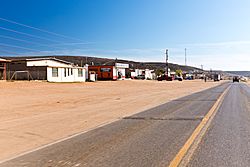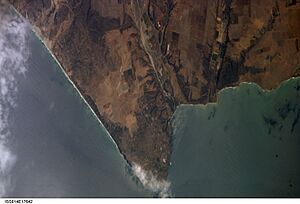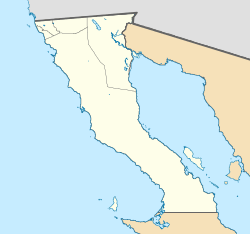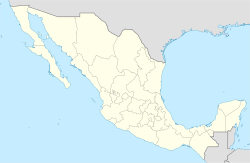Punta Colonet facts for kids
Quick facts for kids
Punta Colonet
Chuwílo Ksaay
|
|
|---|---|
 |
|
| Country | |
| State | Baja California |
| Municipality | Ensenada |
| Elevation | 157 ft (48 m) |
| Population
(2010)
|
|
| • Total | 3,752 |
| Time zone | UTC-8 (Northwest US Pacific) |
| • Summer (DST) | UTC-7 (Northwest) |
Punta Colonet is a town in Ensenada Municipality, Baja California, Mexico. Its name in the Kiliwa language is Chuwílo Ksaay, which means dry arroyo. The town is about 115 km (71 mi) south of the city of Ensenada.
Punta Colonet is known for its farms. Its location near Mexican Federal Highway 1 helps farmers sell their crops. They can easily reach markets in the United States.
Contents
What's in a Name?
The name Punta Colonet comes from Captain James Colnett. He was a British sea captain. He explored this part of the Pacific coast in the late 1700s. The nearby bay and a piece of land sticking into the sea are also named after him. This area has grown a lot in recent years.
Where is Punta Colonet Located?

Punta Colonet is on the southeast side of Arroyo Colonet. Two other communities, Ejido México (also called Ejido Punta Colonet) and Ejido 27 de Enero, are across the Arroyo Colonet. In 2010, Ejido Colonet had 3,278 people. 27 de Enero had 474 people. Together, their population was 3,752.
The town of Punta Colonet is about 15 km (9.3 mi) northeast of a large piece of land called Punta Colonet. This land has gentle hills and dry, shrubby plants. The very tip of this land marks the southern end of the Southern California Bight. This bight is a curved coastline that stretches 545 km (339 mi) northwest to Point Conception in California.
A Look Back at Punta Colonet's Past
During a time when alcohol was illegal in the United States, a Canadian ship called the Malahat was said to have anchored near Cape Colnett. This ship acted as a "mother ship," providing alcohol. This alcohol was then secretly taken north to San Diego.
Plans for a Huge Port
There is a big idea to build a massive deep-water port in Bahía Colonet. This bay is currently quiet and not very populated. The new port would be able to handle the largest cargo ships. It would cover 3,000 hectares, which is more than 7,000 acres. This would make it as big as the Los Angeles and Long Beach ports combined.
This huge port would become the largest in Mexico. It would be the third largest in the world, after Singapore and Hong Kong. The project would also need a new power plant and a plant to make fresh water from seawater. A new 300-kilometre-plus (190 mi) railway line would also be built. This line would connect the port to the United States border.
In 2009, Mexico's Transportation Minister said the project would move forward. They planned to start with a smaller goal of handling one million containers per year. This was less than the original plan for two million containers. Bids for building and operating the port were expected to be between $1 billion and $3 billion.
In December 2009, the Mexican government released plans for the port. They expected Punta Colonet's population to grow from 9,000 to 48,000 within five years. By 2040, it could reach 230,000 people. As of 2022[update] the port has not yet been built.
Why Build This Port?
Building this port could help with crowded ports in the United States. Ports like Los Angeles, Long Beach, and Oakland often get very busy. Ships sometimes wait a week to unload their cargo. This causes delays for businesses.
Punta Colonet would be closer to fast-growing states like Arizona and Nevada. It could offer a way to avoid the busy Los Angeles area. This would save time and money for shipping goods.
The port of Guaymas is also working to increase its cargo traffic. However, this would not stop the need for expansion at other ports like Punta Colonet. Building this mega-port could also create many jobs in Baja California. It would lead to new cities, highways, and railways. This would bring a lot of economic growth.
Who Supports the Port?
A company from Los Angeles, representing Chinese and Korean businesses, wanted to build the port. They aimed to handle between 1.5 million twenty-foot equivalent units (TEU) and 6 million TEU containers. The former President of Mexico, Vicente Fox, supported the port plan.
Ports in the Los Angeles area also generally supported the plan. They saw it as a way to reduce their own congestion. When their ports are too busy, ships with cargo for Los Angeles businesses might have to wait.
Ernesto Ruffo Appel, a former governor of Baja California, and businessman Roberto Curiel Amaya also wanted to bid on the project. They said investors from Asia and Europe were interested. Their plan included building 18 berths at the port. These berths could handle 850,000 TEU containers each year. They also thought about combining the port with an air-freight airport near Ensenada.
What Are the Concerns?
Protecting the Environment
Some people worry about the environmental impact of such a large port. One environmentalist said it might move California's pollution problems to Baja California's beautiful coastline. They argue that this area is one of the last untouched places.
However, supporters say it makes sense to build a large port in a less populated area. They believe proper environmental rules can be followed. Mexico does have environmental rules that are enforced. Environmentalists are also concerned about pollution from ships, trucks, and trains. This includes sewage, toxic paint, and harmful species from ship ballast water. These are real concerns. Many transportation companies are working on solutions to reduce pollution.
Land Ownership
The port would be built on land owned by ejidos. These are small farming communities that own land together. At first, these landowners were not contacted about the port plans. They then joined together with a large property owner. This helped them get involved in the planning process. Now, the landowners have a big say in how their land will be used.
Jobs and Labor
Some people in the United States worry about losing jobs to cheaper labor in Mexico. The success of this project might depend on how Mexican labor is viewed compared to California's port operations.
Mining Rights
Before the port project began, a company called Grupo Minero Lobos received permission to mine for metals like titanium in the bay. This mining area covers 30,000 hectares. This includes the 3,000 hectares planned for the port. Grupo Minero Lobos believes their mining rights also give them rights to the new port. The Mexican government disagrees. They say this would make the port less competitive.
It is likely that both the port and mining projects will move forward. They should be able to work together.
Impact on Astronomy
The nearby National Astronomical Observatory is in the Sierra San Pedro Mártir mountains. It is one of the best places in the world to view the stars. However, light from cities like Tijuana already affects it. A large port like Punta Colonet would create even more light pollution. This could harm the observatory's ability to study space.
Monopoly Concerns
There was also a concern about one company having too much control. The Chinese company Hutchison Whampoa had proposed to build the port. This company controls many major ports around the world, including four important ones in Mexico. Some worried about one company having such a large share of North American ports.
See also
 In Spanish: Punta Colonet para niños
In Spanish: Punta Colonet para niños
Images for kids




